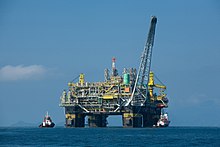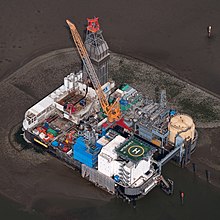
Back منصة نفط Arabic Neft platforması Azerbaijani Нефтена платформа Bulgarian Plataforma petroliera Catalan Ropná plošina Czech Platfform drilio Welsh Boreplatform Danish Bohrinsel German Naftoplatformo Esperanto Plataforma petrolífera Spanish




An oil platform (also called an oil rig, offshore platform, oil production platform, etc.) is a large structure with facilities to extract and process petroleum and natural gas that lie in rock formations beneath the seabed. Many oil platforms will also have facilities to accommodate the workers, although it is also common to have a separate accommodation platform linked by bridge to the production platform. Most commonly, oil platforms engage in activities on the continental shelf, though they can also be used in lakes, inshore waters, and inland seas. Depending on the circumstances, the platform may be fixed to the ocean floor, consist of an artificial island, or float.[1] In some arrangements the main facility may have storage facilities for the processed oil. Remote subsea wells may also be connected to a platform by flow lines and by umbilical connections. These sub-sea facilities may include one or more subsea wells or manifold centres for multiple wells.
Offshore drilling presents environmental challenges, both from the produced hydrocarbons and the materials used during the drilling operation. Controversies include the ongoing US offshore drilling debate.[2]
There are many different types of facilities from which offshore drilling operations take place. These include bottom-founded drilling rigs (jackup barges and swamp barges), combined drilling and production facilities, either bottom-founded or floating platforms, and deepwater mobile offshore drilling units (MODU), including semi-submersibles and drillships. These are capable of operating in water depths up to 3,000 metres (9,800 ft). In shallower waters, the mobile units are anchored to the seabed. However, in deeper water (more than 1,500 metres (4,900 ft)), the semisubmersibles or drillships are maintained at the required drilling location using dynamic positioning.
- ^ Ronalds, BF (2005). "Applicability ranges for offshore oil and gas production facilities". Marine Structures. 18 (3): 251–263. doi:10.1016/j.marstruc.2005.06.001.
- ^ Compton, Glenn, "10 Reasons Not to Drill for Oil Offshore of Florida Archived 2020-08-05 at the Wayback Machine", The Bradenton Times, Sunday, January 14, 2018
© MMXXIII Rich X Search. We shall prevail. All rights reserved. Rich X Search